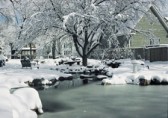Pond Winter Preparation
Published by Dan on Aug 7th 2018
It is hard to believe it is that time of year again. Understanding how to transition the pond through the seasons is very important to understand. With the right techniques and products the transition will be easy and seamless. Follow the guidelines below to better understand the process.
Fall Preparation:
Feeding: In most parts of North America, water temperatures start to drop in early fall (September/October). Make sure you have a pond thermometer to monitor the water temperature as the fall weather progresses. Start changing fish diets to accommodate the changes these cold-blooded creatures will undergo. Wheat-germ foods is ideal to transition fish in and out of winter because it is highly digestible at low temperatures. This is especially important because in the colder months, fishes’ metabolism and the pond’s ammonia-reducing biological activity are greatly diminished. Wean your fish off food as the temperatures go down. When the water temperature is steadily between 55-60° F, only feed the fish wheat germ-based foods once a day and reduce feeding to once a week when the water temperatures stay between 50-55° F. If the temperature stays below 50° F, you can stop feeding them until the weather warms in spring. At this temperature fish will go into hibernation and stop eating. Set up a good thermometer to monitor the water temperature. If your area experiences a warm spell the fish come to the surface be sure not feed them, they may be coming up for air and any food they eat will not be digested.
Cleaning the Pond: Fall is a good time to clean out your pond (before water temperatures fall below 50°F). This is recommended since the fish will still be active and less likely to sustain injuries during cleaning. Scoop up leaves from the surface with a fine net. You may want to pump some of the water out of the pond to expose the planting shelves around the pond. This will make it easier to hand remove leaves that have adhered themselves to the pond edges and shelves. Wash-down rocks. Sprinkle rocks with Algae-Off to loosen debris and let it sit for 20 to 30 minutes before hosing off. After applying the Algae-Off, mist rocks lightly with water. This will help the Algae-Off perform better at loosening the debris. Using a hose nozzle, blast off the accumulated debris and sludge around the pond shelves and edges, and then remove remaining debris with a net or pond vacuum.
When replacing the water after cleaning, add a water de-chlorinator to remove harmful contaminants like chlorine, chloramines and heavy metals.
Pond Netting: Once the pond is clean, this is a good time to add a pond net to protect it from falling and blowing debris. Suspend it at least 18 inches above the surface. Securely fasten the net around the edges to prevent leaves from finding their way underneath it. If you have frog inhabitants, it is helpful to leave a small opening or two to provide them access to and from the pond. Avoid letting the net sag into the water. Not only will it create a hazard for your fish, but leaves will collect in the submersed area and decay.
Plants: Plant life can also be a source of debris. As marginal and deep-water aquatic plants begin to die back, prune dead stems and leaves to prevent decay in the water during the winter. In late fall, we recommend removing non-hardy aquatic plants like Water Hyacinths or tropical lilies from the water. You can store their plants in warm conditions until next year.
For marginal plants in baskets around the perimeter of the pond, move them to deeper water to prevent them from freezing in pond ice. Hardy water lilies can be left in deep end of the pond over the winter. Bog plants can be insulated with straw or a commercial insulating material.
Treatment: Fall is a great time to add Winter Bacteria Prep. This will get your pond water ready for a clean & clear spring! Winter Bacteria helps accelerate the decomposition of leaves, sediment and other organic matter during the fall and winter months. Winter Bacteria continues to provide sustained biological activity even in water temperatures under 40 degrees.
Pond Closing: The first step is to determine when you should shut down the pond equipment: pump, filter and UV clarifier. If your winter temperatures are moderate, you may continue to run your pump to keep the pond surface from freezing.
Further north, where temperatures are more extreme, we recommended shutting the pond down for two reasons. First, the pump will mix colder surface water with the slightly warmer temperatures in the pond bottom where fish take comfort and hibernate. Second, you risk the chance of diverting water out of the pond and emptying it when the flowing water begins to form ice, especially on features like waterfalls or streams.
Store your equipment indoors safe from the elements. It’s also a good idea to clean and inspect the equipment and replace any broken components. When shutting down the pumps, filters or any other equipment make sure there is no water left in the device that may ice up and cause the body/housing to break. If kept inside it helps to place the pump, if it is submersible, in a bucket of water to prevent the rubber gaskets and seals from becoming brittle and failing. Remove the filter mats, the skimmer mats. Hose off until clean and store in the garage or shed.

Winter Preparation:
In the northern climates this is a question that I hear quite often. Do I need to install pond de-cer or pond aeration equipment? An argument can be made that one is more important than the other; however both can keep an area of the pond surface free from ice.
During the winter months your fish are still producing waste and CO2. Decomposition of the fish waste and any organic material during the winter produces harmful compounds that will rob the water of oxygen causing stress to the fish. If water toxicity levels get too high the fish could die. When the pond is not frozen the gasses escape through the surface. Thus it is essential to keep an area in your pond free from ice. Both a fish pond deicer and a pond aerator pump have positive and negative points.
POND DEICER: This is the easiest way to keep your pond free of ice. The pond heater is designed to heat the area around it, not the whole pond. It will not change the overall temperature of the pond water.
Most pond heaters are thermostatically controlled. The negative side to heaters for a pond is if it gets really cold or windy the space around the fish heater can freeze over creating a dome. It's important to protect the fish pond heater from the wind and inspect it often.
AERATORS for PONDS: The pond air stones do a good job of keeping a space open in the ice. Exactly what is pond aeration? A pond aeration system adds oxygen. As the air is moving through the water it allows the organic compounds that are in the water to attach and when the bubble hits the surface the gasses break apart releasing them safely into the atmosphere. We recommend pond aeration systems. These systems you can use throughout the year to reduce algae growth during heat waves and create a nice opening in the ice during the winter months using minimum electricity. The air pump should be placed in a dry, sheltered area, out of the rain and moisture. The airstone should be suspended no more than twelve inches from the surface of the pond. You do not want to disturb the warm water at the bottom of the pond. During winter months, keep the air stone close to the surface of the pond keeping the warmer water just below the air. If the air compressor is out in the cold air it is transferring that cold air to the pond water. This could cause stress to the fish
Some pond owners use a combination of both a pond heater and pond aerator. Just be sure to do one or the other.
Caring and Feeding Fish throughout the Winter: In most parts of the United States it’s best to leave fish in the pond during the winter, providing the depth of the pond is adequate (18” or deeper) and there is little or no water circulation. The denser, warmer water will sink to the bottom of the pond, where it will be insulated by the cooler surface water or ice, and fish will gather in this deep, warm area. Some types of fish, such as fancy goldfish with ornate tails, bubble eyes and lionheads, are sensitive to cold weather and should be brought indoors.
As winter approaches, pondkeepers should monitor pond water temperatures daily. Taking these few steps now will ensure their fish will survive the winter and they are sure to enjoy a successful pond season next year.

Fall/Winter Pond Checklist:
To ensure you cover all of the necessary fall pond prep steps, keep this checklist handy:
- Clean out the pond as outlined above.
- Cut back dead or dying aquatic plant foliage during the fall.
- Place a pond net over the pond to reduce the number of leaves falling into the pond.
- Purchase a wheat-germ-based pond food developed especially for a spring and fall Diet.
- Disconnect the pump, filter and UV clarifier before water freezes. Store pumps, filters, UV clarifier indoors for protection.
- Place a pond de-icer to melt a small opening in the surface and/ or purchase a pond aerator allowing noxious gasses to escape.
- Add Fall/Winter Bacteria.

